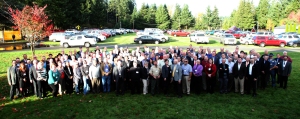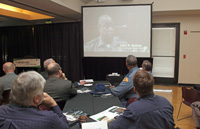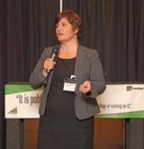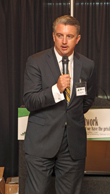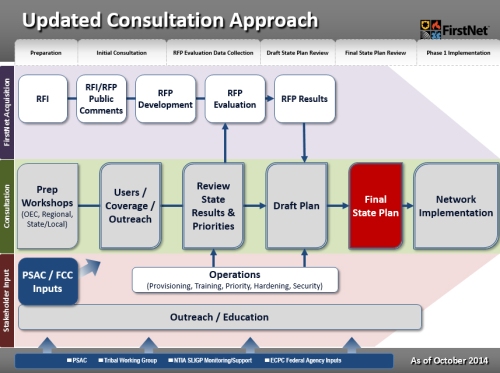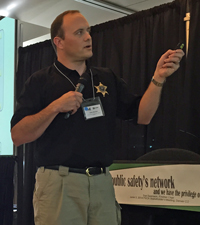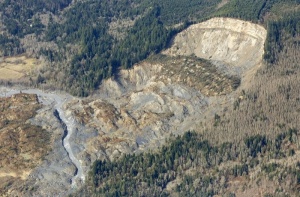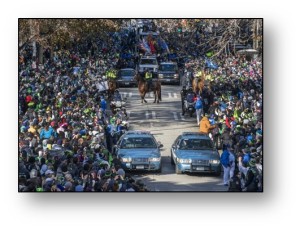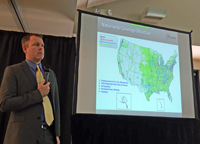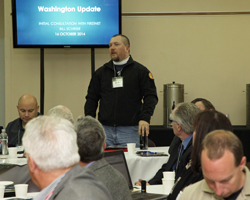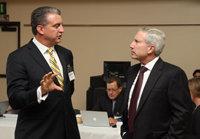The First Responder Network Authority (FirstNet) came to the “other Washington” on October 16, 2014, and officially launched the design process for FirstNet in Washington. We taught FirstNet a few lessons about the public safety needs in Washington State. And we learned a bit about how FirstNet will design a network to serve responders in Washington.
“Consultation”
“Consultation” has a special meaning in FirstNet-speak.
We conducted the consultation meeting from 9:00 AM to 4:30 PM at the Thurston County Fairgrounds outside of the State Capital, Olympia. About 180 responders and other stakeholders from around the state attended .
The purpose of this “initial” consultation was to launch a design process for FirstNet in Washington. We think this will take about 18 months, but that’s definitely a guesstimate based on a variety of factors, including how rapidly FirstNet can issue its RFP for vendor partners, get responses, and evaluate them.
During this consultation period FirstNet will provide technical expertise and other input to build a State Plan and design for the network in Washington. Responders in Washington will provide information about their needs for coverage, usage, devices, applications and other capabilities in order to improve public safety for the people of Washington. Responders will specify what sort of support they need in this world of rapidly mutating technology including smart phones, tablet computers, apps, wearable computers, tiny video recorders, the “Internet of things” and much more. And by “responder” we’re talking about anyone who has a role in responding to a public safety emergency and disaster: firefighters, cops, paramedics, electric and water utility workers, transportation workers, transit drivers, the Red Cross and Salvation Army and others. Even school teachers, alas, are too often first responders as we found out again at Pilchuck High School in Marysville on October 24th.
The end of this consultation process is a State Plan (capital letters) for FirstNet in Washington presented to Governor Jay Inslee, who will, after consulting with our state’s responders, either opt-in or opt-out of the plan. The State Plan, like all State Plans developed for the 56 states and territories, should include elements such as what parts of the state will be covered permanently, who will be authorized to use FirstNet in Washington, how much users will need to pay and many more elements about how the network will operate in our state.
How the Day Proceeded
We started the day by showing the short version of our “FirstNet in Washington” video (see it here), which features Washington State Interoperability Executive Committee (SIEC) members discussing what FirstNet might mean for the State’s responders. This is a fairly dramatic video, with statements from Washington State Patrol Chief John Batiste, Pacific County Emergency Management Director Stephanie Fritts (Pacific County is subject to both earthquakes and tsunamis), Quinault Tribe Technology Leader Randell Harris, West Pierce Fire Chief Jim Sharp, Whitcom 911 Director Patti Kelly, and Edmonds Police Chief Al Compaan.
We had welcomes from Sandy Mullins (pictured at left), who is Governor Jay Inslee’s advisor for Public Safety, and Michael Cockrill, the State’s Chief Information Officer (CIO). The FirstNet effort in Washington State is managed inside the Office of the CIO.
After the video, FirstNet General Manager T. J. Kennedy took the floor to provide a welcome from FirstNet. He described the significant efforts FirstNet is undertaking to prepare for, design and build this nationwide network, a daunting effort unparalleled in United States history. Kennedy mentioned the Request for Information (RFI) and Public Notice (PN) from which FirstNet hopes to gain input to drive its future plan. The RFI seeks information to guide FirstNet’s 2015 RFP for the network. The public notice seeks ideas about who should be able to use the network, among other topics.
Rich Reed, FirstNet’s Director of State Plans talked about some of the recent history of FirstNet, such as the regional meetings conducted in mid-2013. He described what went on at those meetings as “shockingly unimplementable” and that’s definitely true . The FirstNet Board members who led those meetings were far too optimistic on schedule and effort.
Rich Reed characterizes the information presently available as “what we know”, “what we don’t know” and “what we think”, and answers questions within that framework. For example, the law which created FirstNet contains 24 Congressional mandates. As another example, FirstNet’s shelf life is from 2012 to September 30, 2022, when the authority and funds end unless renewed by Congress.
Some other highlights of Reed’s talk:
- FirstNet is keenly aware it must “earn the business” of each public safety agency by offering equal or superior products, services and support.
- Consultation with States does not end when FirstNet delivers the State Plan to Governor Inslee (or any other Governor). Consultation will continue as FirstNet implements in the state, builds its network, and then expands it based upon the needs of the state’s responders.
- Will there be one vendor partner or many partners to build out the network? This is unknown.
- Will devices be able to talk to other devices via Bluetooth, boomer sites, small cells and so forth? All such technologies are on the table.
- Reed, Buchanan and Kennedy also talked about the updated, streamlined, approach to State consultation which is shown in the image below:
Needs for FirstNet in Washington
Four senior officials from local government presented practical examples of challenges and disasters they have faced in 2014, some of the communication problems they had, and how a robust wireless data network may be able to improve response and recovery in the future. The slide deck used in these presentations is on the Washington OneNet site here.
Okanogan County Wildfires and Floods
Okanogan County, and other counties in Washington experienced one of the worst wildfire seasons on record. Okanogan County suffered from the largest wildfire in recorded state history, measured in geography, the Carleton Complex fire. This fire raged in July and August 2014 and burned 400 square miles, destroying 237 homes and 55 cabins. The fire was ultimately extinguished partially as a result heavy rains, but those rains caused flooding and torrential stream flows, causing further damage. One death is attributed to the fire.
Okanogan County Senior Deputy Mike Worden (photo at right) discussed the interoperable communications challenges of the event. These included:
- Over fifty to sixty miles fiber optic cable, mounted on wooden poles, was lost, cutting 911 service to many residents and connections to some commercial cell sites. At least one undergrounded fiber was cut when the fiber which ran under a bridge melted.
- While the Sheriff’s Department has mobile data computers in deputy vehicles, most city police departments and local fire departments do not have such access to wireless data communications. No public safety land-mobile radio (LMR) sites were lost, although at least one site operated on generator during an extended power outage due to loss of electrical lines and service. One public safety site in Oroville lost coverage due to loss of phone lines which serve as backhaul to that site.
- The Sheriff’s department used automatic vehicle location (AVL), mobile digital maps, instant messaging and electronic mail to coordinate evacuation of residences.
- The Sheriff’s department tracked routes and locations which had now mobile data coverage and has maps to support improvement of that coverage.
After Worden’s presentation, he and the audience discussion extracted several lessons learned from this event:
- All local and state agencies need to invest in mobile data devices (computers, smart phones, tablets) for their field officers to better share situational awareness and a common operating picture. Perhaps this use needs to be subsidized if local agencies cannot afford it.
- Affordability of mobile data devices and ubiquitous use of them is key to responding both to daily incidents and major disasters like this.
- Interoperability with state and federal agencies is also important to wildfire response. Such agencies include Washington Department of Transportation (WSDOT), Washington State Patrol (WSP), Washington Department of Natural Resources (DNR – which is primarily responsible for wildland firefighting), federal Bureau of Land Management (BLM) and federal National Forest Service (NFS) part of the Department of Agriculture.
- Mobile data use by responders is, more and more, becoming a “necessity” rather than a “nice-to-have”.
Snohomish County State Route 530 Landslide
Scott Honaker, the Radio Officer at the Snohomish County Department of Emergency Management (DEM), discussed the challenges and lessons learned from that event.
The State Route 530 landslide occurred on Saturday, March 22, 2014. It destroyed 36 homes directly and 9 more by flooding. Forty-three people died in the slide. Everyone who could be rescued was rescued in the first 12 hours, but the recovery operations continued for six weeks with up to 1,000 responders deployed in the 1500 foot long, 4400 foot wide landslide area.
Some of the interoperable communications challenges detailed by Honaker included:
- Lack of situational awareness was a challenge during the first 48 hours. Few responders realized the size or extent of the slide, and accurate data on the number of people missing took a week to assemble. Ironically some situational awareness was available from Navy, Snohomish, King County and private air ambulance helicopter pilots during the recovery phase, but there were few paths to accurately convey this data to incident commanders on the ground.
- The slide severed a fiber optic cable connecting the town of Darrington to the outside world for communications. This cut Darrington off in terms of 911 calls, Internet and land-line telephone service. One commercial cellular provider, Verizon, retained connections. 911 Center staff quickly worked with Frontier communications to reroute 911 calls to a police substation in Darrington. Other commercial cellular providers lost connectivity due to the loss of the fiber line.
- Volunteers were extensively used in the recovery operation. Many of them had friends and relatives whose bodies were buried under the debris; furthermore, these volunteers had the proper equipment (logging equipment, bulldozers) to move the debris.
- Commercial cellular and land-line carriers – especially Verizon and Frontier, but also AT&T, provided extraordinary support during the event. For example Verizon assigned technicians to the event 24×7 and Frontier restored the fiber line to connect Darrington within three days.
- Video downlinks from Snohomish and King County helicopters and Washington State Patrol aircraft were available, but only one or two receivers were available on the ground for receiving the video, and there was no way to distribute it via data communications to incident commanders and responder devices.
- A detailed report on the land-mobile radio challenges and lessons learned is here.
Some of the lessons learned for FirstNet discussed by the audience include:
- FirstNet must have operational capability to immediately respond on site with technical staff to support communications after a disaster.
- It is extraordinarily important for all responders and responder agencies to have certain common applications on their mobile data devices to share situation awareness and communications during the response, but also the recovery phase after disasters.
- Aircraft – helicopters, airplanes and drones – are very important to situational awareness, but communicating information obtained from such sources is difficult. This information includes video, LIDAR and other scanning technologies as well as voice and GPS data.
- In a complex event, situational awareness must be distributed across a wide variety of teams involved in the response – local and state police, local firefighters, DNR, WSDOT, FEMA, city, county and state Emergency Operations Centers (EOCs), Urban Search-and-Rescue, search-and-rescue (SAR) volunteers, other volunteers (like loggers), National Guard, Coast Guard, and the Navy in this case. Common applications and/or common use of a network like FirstNet could vastly improve situational awareness during the critical first hours of response.
Seattle Seahawks Victory Parade
Captain Dick Reed attended the morning session of the initial consultation, but was called away before he could talk about communications challenges during the Seahawk victory parade. Some of those challenges have been detailed in the public media, such as this Seattle Times article.
The parade on February 5, 2014, drew an estimated 700,000 people to downtown Seattle. Cellular network providers tried to provide additional network capability via cell-on-wheels (COW) and similar apparatus. Nevertheless many cell phone calls and much wireless data communication was unusable for over three hours. Fortunately there were few major incidents. Many responders from multiple agencies came to mutual aid of the City of Seattle to support the event. LMR networks (King County 800 MHz radio) performed flawlessly, and in several cases citizens came to police officers or firefighters along the route to request aid, and those responders were able to use their 800 MHz trunked radio to summon aid. Nevertheless the mobile data computers, smart phones and tablet computers of all responders were affected just like citizens and parade observers.
The Seahawks Victory Parade experience supports the need for a dedicated network for use by responders.
Engaging Washington Responders in the FirstNet State Plan
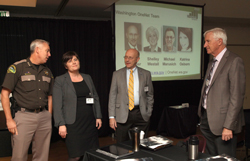
Thurston County Sheriff John Snaza, Sandy Mullins, Bill Schrier, State Emergency Management Director Robert Ezelle
Finally, as the FirstNet State Point of Contact (SPOC), I discussed how Washington OneNet and Washington’s responders will engage with FirstNet during the consultation process to develop the state plan (slides of the presentation are here).
Washington has engaged the Washington State University (WSU) Division of Governmental Studies & Services and the Pacific Northwest Economic Region (PNWER) as subcontractors to continue outreach, education and data collections in support of Washington OneNet. WSU will be contacting first responder agencies and elected officials throughout the state to make them aware of the FirstNet design effort and engage them in developing the State Plan. Similarly PNWER will engage public works, utilities and similar responders in the effort. This work will kick off in earnest in January, 2015.
Washington will form three committees – a stakeholder committee, technical committee and operational committee. The Operational Committee will be led by Jim Pryor, retired assistant police chief in Seattle, and will consist of invited individuals who have performed as a public safety incident commander.
The Operational Committee will explore and make recommendations to the SIEC regarding operational aspects of FirstNet’s dedicated Public Safety Wireless Broadband Network in Washington State. The Committee will consider such issues as network management/prioritization during critical incidents and normal use; availability and use of multi-disciplinary applications on the network; establishing operational guidelines when interfacing with local, state, federal, and military entities; and, other topics that might be referred to the Committee to take advantage of the experience, background, and training of its members.
The Stakeholder Committee will be composed of elected officials and senior officials of responder agencies to consider questions such as coverage, where incidents occur, who is a “responder” and should be authorized to use the network, costs and affordability.
The Technical Committee will support FirstNet’s work in technical design – including deployable sites (e.g. sites on fire apparatus, drones, and similar platforms), in-building coverage, distributed antennas, throughput speeds, and micro-cell-sites, implementing priority and similar issues.
The goal of these Washington State efforts is not to “sell” FirstNet, but rather to get a design for Washington State which meets the needs of our responders and citizens.
What FirstNet Needs from Washington
In the afternoon of the initial consultation, Brian Hobson (photo at right, with a coverage map) and Rich Reed of FirstNet described the sorts of information FirstNet needs to design a network and prepare a State Plan for Washington. They discussed:
- The need to find incident management data such as computer-aided-dispatch (CAD), records management system (RMS) and 9-1-1 call data to map the location of incidents in the state, which in turn drives coverage mapping.
- Coverage maps of the existing state and local LMR networks are a good starting point for coverage mapping.
- FirstNet will do a phased build-out in Washington. What are the appropriate phases? Washington’s elected officials and responders need to define that. For example, Washington might want to do a reverse build-out with the areas with high need but poor coverage being the first to be built out.
- Washington might consider how to manage feedback loops and processes for managing further expansion of the network.
Next Steps for Washington State
- Continue outreach & discussion with responder agencies and Tribes.
- Begin collection of data elements. These include information such as names of potential user agencies, a point of contact in each agency, the potential number of FirstNet users in each agency, applications which are presently in use, and so forth.
- Consider coverage, capacity, users and other input Washington has for the FirstNet State Plan.
- Work with FirstNet staff on the State Plan.
Next Steps for FirstNet
- Hire staff members in Federal Region X (Washington, Oregon, Alaska and Idaho) to support work on the state plan.
- Develop template of specific user data and information, which states should collect to support the development of the State Plan.
- Assimilate input from the RFI and publish a draft RFP, probably in first quarter of calendar year 2015, to solicit vendors and partners to build the network.
Challenges for a FirstNet State Plan in Washington
East and West. While we had a good attendance from around the state, it was hard to get representatives from Eastern Washington. Washington, like most states, has a “divide”, and in our case it is “east of the Cascade Mountains” and “west of the mountains”. When a meeting is held on one side, attendance from the other falls off. We also are using our state-and-local implementation planning grant (SLIGP) funds to pay for travel, lodging and per diem of public officials who attend the meeting, but they still need to be away from their day jobs, a real challenge for smaller cities and rural counties who do not have a lot of staff.
Indian Country. We had 7 representatives from Indian tribes, including Mike Lyall, Vice-Chair of the Cowlitz tribe and Robin Souvenir, Police Chief for the Shoalwater Bay Tribe (photo at right). The Cowlitz have a huge reservation in the central part of the state and the Shoalwater Bay Tribe is in Pacific County, vulnerable to tsunami and also in the shadow of a cliff, with poor commercial cell coverage. Nevertheless we have 29 federal recognized tribes in the state – and some additional tribes beyond those – so we have more work to do to engage our tribes who are federal governments. Besides the Cowlitz, other tribes in the state cover a large geography and are economically and culturally important to our state. We have much more work to do to engage them all.
Urban, suburban and rural first responders. We had good participation from rural and suburban agencies, including police, fire and emergency medical, plus 911 centers (PSAPs) and emergency managers. We didn’t get a lot of responders from larger cities such as Spokane, Seattle and Tacoma, although we had good participations from their counties – Spokane, King and Pierce.
Lessons Learned
Washington OneNet offers a number of lessons and suggestions for other states who are going to conduct an initial consultation.
Prepare user stories/case studies. The user stories and case studies are a phenomenal chance to engage Firstnet about the unique challenges of the state and its responders. But it is also helpful for the state’s own responders to hear about the issues faced by other responding agencies in the state. Washington, unfortunately, has had too many disasters, just in 2014, and therefore faces many mobilizations and challenges. Other potential disasters loom, including a magnitude 9.0 earthquake, lahars, volcanic eruption and terrorism due to a long international border and a long coastline.
Hallway conversations are half the event. “Virtual meetings” like WebEx and Go-to-Meeting will never replace meeting people at a live event. T. J. Kennedy and other FirstNet staff really “worked the room” meeting with Washington State responders, as did Washington OneNet staff. Kennedy’s background as a first responder makes him a powerful ambassador for FirstNet and a great person to engage police and fire chiefs, as well as elected officials. These individual and personal touches are the foundation for future engagement to build the State Plan. (Photo at right: T. J. Kennedy talks with retired Seattle Police Assistant Chief Jim Pryor).
Summary
If the design, planning, construction and implementation of the First Responder Network in the State of Washington is a 26 mile, 385 yard, marathon, the initial consultation we conducted on October 16th is the first 100 yards. We’re off to a running start, but there’s a long, sometimes difficult, sometimes enjoyable, 26 mile, 285 yards to go. The general road map to the final network is in place, but the hills, valleys and curves are yet to be plotted and overcome. Over the next several years responders from throughout Washington will work with FirstNet to create a State Plan and then will see it to implementation. At that point each city, county, police and fire department, electric utility, public works and other responder agency will need to decide if the new FirstNet will meet their specific needs. Getting to a great design will be a major portion of the effort.

